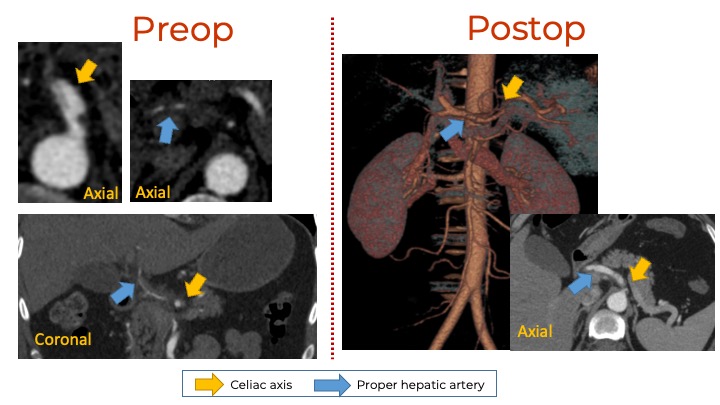Symptomatic Flow Limiting Isolated Celiac Artery Dissection
Akiko Tanaka, MD, PhD, Hazim J. Safi, MD, Kourosh Keyhani, DO, Arash Keyhani, DO.
McGovern Medical School at UTHealth, Houston, TX, USA.
DEMOGRAPHICS: A 44-year-old female presents with acute worsening of right flank pain.
HISTORY: The patient is a 44-year-old female with a history of menorrhagia secondary to uterine fibroids who presented with acute right flank pain with nausea and vomiting to the emergency room. Labs were normal including hepatic function panel and lipase. Right upper quadrant ultrasound showed no significant findings including normal gall bladder. Computed tomography was then obtained, which demonstrated an isolated dissection of the celiac axis extending to the common hepatic artery and to the proper hepatic artery with compressed true lumen from the thrombosed false lumen. The patient did not recall any abdominal trauma nor has a family history of connective tissue disorder.
PLAN: She was initially started on heparin infusion and oral aspirin, but her symptoms persisted for next two days, and was not able to tolerate diet. A repeat CT angiogram (CTA) was unchanged. Thus, the decision was made to proceed with intervention.
DISCUSSION: Spontaneous isolated celiac artery dissection is often amenable to conservative management. However, in the current case, the dissection was extended to the proper hepatic artery with severely compressed true lumen by the thrombosed false lumen. Thus, which required early intervention. Thrombolysis therapy has been reported with mixed outcomes, and also considering her history of severe anemia due to fibroids, it was not indicated. We performed balloon angioplasty to the common hepatic, proper hepatic, and left hepatic arteries. The size of the common hepatic artery was 3 to 4-mm. Due to the small size artery, extensive dissection, and flow to hepatic arteries being restored after the angioplasty, the decision was made not to stent at this point. Her symptoms resolved immediately after the procedure. A repeat CTA after 37 days demonstrated near complete remodeling of the celiac artery dissection.

Back to 2022 Abstracts
